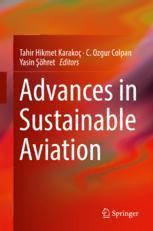
Advances in Sustainable Aviation PDF
Preview Advances in Sustainable Aviation
Tahir Hikmet Karakoç · C. Ozgur Colpan Yasin Şöhret Editors Advances in Sustainable Aviation Advances in Sustainable Aviation Tahir Hikmet Karakoç (cid:129) C. Ozgur Colpan Yasin S¸öhret Editors Advances in Sustainable Aviation 123 Editors TahirHikmetKarakoç C.OzgurColpan DepartmentofAirframe DepartmentofMechanicalEngineering andPowerplantMaintenance DokuzEylulUniversity,Facultyof AnadoluUniversity,FacultyofAeronautics Engineering andAstronautics Buca,Izmir,Turkey Eskisehir,Turkey YasinS¸öhret DepartmentofAirframe andPowerplantMaintenance SüleymanDemirelUniversity SchoolofCivilAviation Isparta,Turkey ISBN978-3-319-67133-8 ISBN978-3-319-67134-5 (eBook) DOI10.1007/978-3-319-67134-5 LibraryofCongressControlNumber:2017956935 ©SpringerInternationalPublishingAG2018 Thisworkissubjecttocopyright.AllrightsarereservedbythePublisher,whetherthewholeorpartof thematerialisconcerned,specificallytherightsoftranslation,reprinting,reuseofillustrations,recitation, broadcasting,reproductiononmicrofilmsorinanyotherphysicalway,andtransmissionorinformation storageandretrieval,electronicadaptation,computersoftware,orbysimilarordissimilarmethodology nowknownorhereafterdeveloped. Theuseofgeneraldescriptivenames,registerednames,trademarks,servicemarks,etc.inthispublication doesnotimply,evenintheabsenceofaspecificstatement,thatsuchnamesareexemptfromtherelevant protectivelawsandregulationsandthereforefreeforgeneraluse. Thepublisher,theauthorsandtheeditorsaresafetoassumethattheadviceandinformationinthisbook arebelievedtobetrueandaccurateatthedateofpublication.Neitherthepublishernortheauthorsor theeditorsgiveawarranty,expressorimplied,withrespecttothematerialcontainedhereinorforany errorsoromissionsthatmayhavebeenmade.Thepublisherremainsneutralwithregardtojurisdictional claimsinpublishedmapsandinstitutionalaffiliations. Printedonacid-freepaper ThisSpringerimprintispublishedbySpringerNature TheregisteredcompanyisSpringerInternationalPublishingAG Theregisteredcompanyaddressis:Gewerbestrasse11,6330Cham,Switzerland Preface Therapiddepletionoffossilfuelsandincreasingconcernsregardingenvironmental problemsarepromptingustodevelopmoreefficientenergysystemsforasustain- ablefuture.Theaviationsector,includingairandcargotransportation,management of air traffic,management of airportterminals and associated buildings, numerous manned and unmanned aerial vehicle operations, and so on, is one of the fastest growing sectors in the last decade. The number of aircrafts in service, managed airports, and people using air transportation are increasing every day. Given this growth,thesustainablemanagementofenergyintheaviationsectorisvital. Thisbook,SustainableAviation:AdvancesinSustainableAviation,presentsthe state-of-the-artsustainableaviation.Thebookcompilesselectedoutstandingpapers presented at the International Symposium on Sustainable Aviation 2016 (ISSA- 2016).ThiseventwasheldinIstanbul,Turkey,fromMay29,2016,toJune1,2016, with the participation of researchers, scientists, and academics from all over the world.Thecontributionofleadingaviationcompaniesanddistinguishedscientists inthefieldofaviationturnedtheeventintoaplatformwherethefutureofthesector wasdiscussed. The book is composed of 4 parts and 20 chapters in total. Each chapter in the book aims to present an issue and solution on how to achieve more sustainable aviation.Thefirstpartofthebookincludesresearchassociatedwithaviationfuels andcombustiontechnologies.Recentstudiesonaerodynamicsarepresentedinthe second part of the book. The third part involves energy and environmental issues associated with the aviation. The last part of the book addresses the advances in employmentofelectronicsystemsandcontroltechnologiesinaviation. This book provides a unique source of sustainable aviation with a prime focus onadvancesinsustainableaviation.Thecontributionsoftheauthorsandreviewers andtheassistanceprovidedbytheconferenceorganizingcommitteemembersinthe preparationofthisbookaresincerelyappreciated. Eskisehir,Turkey T.HikmetKarakoç Izmir,Turkey C.OzgurColpan Isparta,Turkey YasinS¸öhret v Contents PartI AdvancesinFuelandCombustion 1 EnvironmentallyCleanReformulatedAviationGasoline.............. 3 OlesiaKondakovaandSergiiBoichenko 2 IgnitionPerformancesofAlternativeFuelsUnderAltitude ConditionsAccordingtoTheirAromaticContent...................... 15 RenaudLecourt 3 ReviewofRenewableBiofuelsintheAviationSector .................. 25 DeryaUnluandNiluferDurmazHilmioglu 4 Case Study of Alternative Jet Fuel Production withBio-additivesfromPlantOilsinUkraineandPoland............ 41 AnnaYakovlieva,SergiiBoichenko,OksanaVovk,KazimierzLejda, andOleksandrGryshchenko 5 Developmentofa3DGrainBurnbackSimulationTool forSolidRocketMotors.................................................... 65 YusufAta,D.FundaKurtulus,andO.UgurArkun PartII AdvancesinAerodynamics 6 A Prediction of Aerodynamics of Arbitrary Shape Non-fragmentingSpaceDebrisDuringDecayWithoutAblation..... 93 Sayavur I. Bakhtiyarov, Ramiz S. Gurbanov, Eldar T. Abdinov, andNadirYilmaz 7 PerformanceofaPropeller-DrivenCargoAirplane.................... 103 KasımBiber 8 NumericalInvestigationofanS-DuctDiffuseratDifferent InletBoundaryConditions ................................................ 111 SametAslanandD.FundaKurtulus vii viii Contents 9 Numerical Investigation of a Serpentine Inlet Validated withExperimentalResultsforDifferentTurbulenceModels.......... 129 Samet Aslan, D. Funda Kurtulus, Ender Hepkaya, andSefaYilmazturk 10 Aerothermal Investigation of a Turbine Cooling Channel withU-Bend................................................................. 139 IsaKavas,TolgaYasa,andD.FundaKurtulus PartIII EnergyandEnvironmentalIssues 11 Environment-FriendlyTechnologyofAirport’sSewerage............. 161 SergiiShamanskyiandSergiiBoichenko 12 StatisticalModelDevelopmentforMilitaryAircraftEngine ExhaustEmissionsData ................................................... 177 Akhlitdin Nizamitdinov, Yasin S¸öhret, Aladdin Shamilov, andT.HikmetKarakoç 13 TheImprovementofEnergy-SavingPerformanceatUkrainian Airports...................................................................... 189 MargarytaRadomska,LarysaChernyak,andOlexandrSamsoniuk 14 ShipEmissionsandHumanHealthRelationship:ATheoretical andNumericalInvestigationinAsyaport................................ 205 M.SunerandE.Yalcin 15 SmartProtectiveClothingforAircraftCrew ........................... 221 Emel Onder, Ezgi C. B. Noyan, Sena C. Duru, Cevza Candan, SelcukPaker,andRafetSayar 16 AdvantagesandFutureofElectricPropulsioninUAVs................ 237 MelihYildizandT.HikmetKarakoç 17 GreenizationFactorofaTurbojetEngine............................... 243 YasinS¸öhretandT.HikmetKarakoç PartIV AdvancesinElectronicsandControlTechnologies 18 Integration of Baro-Inertial-GPS Altimeter via ComplementaryKalmanFilter ........................................... 251 AlbertoMañeroContrerasandChingizHajiyev 19 TestingtheDeterminantoftheInnovationCovarianceMatrix AppliedtoAircraftSensorandActuator/SurfaceFaultDetection ... 269 ChingizHajiyevandUlviyeHacizade 20 New Approach to the ATC-Pilot Radio Communication PhraseologyPhoneticConfusion.......................................... 285 OrhanErtugrulGuclu Index............................................................................... 291 Part I Advances in Fuel and Combustion Chapter 1 Environmentally Clean Reformulated Aviation Gasoline OlesiaKondakovaandSergiiBoichenko Production of fuel for aircraft engines is one of the priorities of world refining industry. Due to growing air traffic intensity, it is necessary to improve the fuel efficiency of aircraft and fuel quality. As soon as provision with high-quality fuel is a decisive issue of aircraft efficiency, saving and rational use of aviation fuels becomeofnationalimportance. Aviation gasoline blend components are obtained in various technological processes.Thebasiccomponentintheproductionofgasolineiscatalyticreforming atwhichthearomatizationandisomerizationofstraightgasolineistheoutput.This increases its detonation resistance. Additional components with a high detonation resistance – alkylate, isooctane technical, pirobenzol, ethyl liquid, isopentane, and toluene–areenteredintothecompositionoffuels(Table1.1). The main indicator of gasoline quality is its detonation stability. This is an ability of fuel to burn without detonation in piston engines with spark ignition; octanenumberhasdirectinfluenceonoperationalandenvironmentalperformance oftransport. Buttoday,alltheknownbrandsofaviationgasolineusetetraethylleadasanti- knock additive in spite of its toxicity. Thus, for aviation piston engines, according toGOST1012,aviationgasolinebrandsB-95/130andB-91/115,whoseoilfraction boilswithin40–180ıC,areproduced.Todayknownbrandsofaviationgasolineare B-92(µ¶38.401-58-47-92) andB-70(µ¶38.101913-82) withlowconcentration of TEL. DEF STAN 91-90 Issue 3 reflects requirements for AVGAS 100LL, AVGAS100,andAVGAS80.AccordingtoASTMD6227,newaviationgasoline 82UL, which already contains TEL, is introduced, but its testing has not yet been completed. Having analyzed these documents, we have compiled a comparative table(Table1.2)presentingTELcontent inaviationgasoline[3].Thetableshows O.Kondakova((cid:2))(cid:129)S.Boichenko NationalAviationUniversity,Kyiv,Ukraine e-mail:[email protected] ©SpringerInternationalPublishingAG2018 3 T.H.Karakoçetal.(eds.),AdvancesinSustainableAviation, DOI10.1007/978-3-319-67134-5_1 4 O.KondakovaandS.Boichenko 5 ylate ––71 180 data data Alk 698 40– 90 No No e n nta 00 e 2 5 3 Isop 626. 27.8 90.3 900/ 4 e n e z Piroben 850 80–175 88 Nodata Nodata e 0 n 8 Benze 878–8 80.1 111.6 5 2 oluene 65–867 10,6 02.1 50 T 8 1 1 1 3 1 5 e 92. 9.3 Isooctan 691.8–6 99.15–9 100–99 300 4 s senit au cre10 n iy nb 1] cane –2 onoli [19 ditigas ponents aTEL 1650 80 0.1%adTELon 0.0001 1 m o c of h-octane ntration g e ofhi 3mıC conc Table1.1Characteristics №Indicatorı1Densityat20C,kg/ 2Boilingtemperature,b3MON 4Maximumallowable3workingarea,mg/m 5Hazardclass aTetraethylleadbMotoroctanenumber
